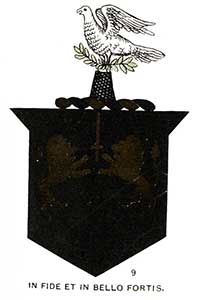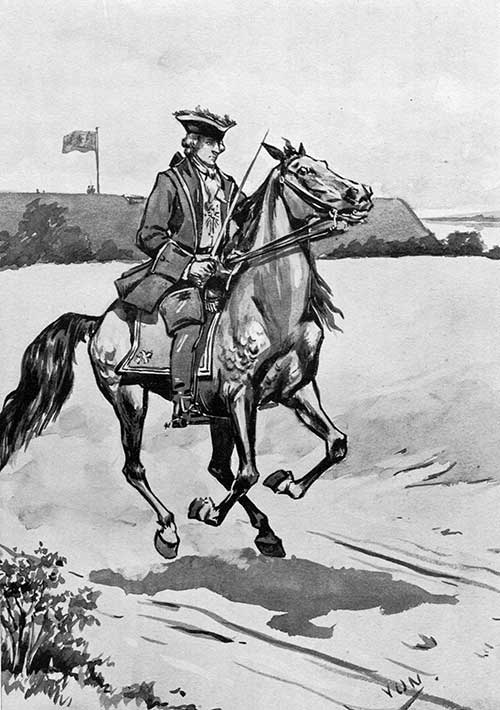The Carroll Family

(Crest No. 9. Plate 2.)
THE Carroll family is descended from Milesius, King of Spain, through the line of his son Heber. The O’Carrolls belonged to the Kianachta tribe, founded by Kiann, son of Olliol Ollum, first absolute King of Munster, A. D. 177, and his consort Sabia, daughter of Con of the Hundred Battles, King of Ireland, A. D. 148.
The founder of the family was Kieran, son of Sedna, son of Trena, son of Tigernach, of the race of Kian.
The original name was Ciarail, or Cearbhoil, and signified “Perverse.” The titles of the chiefs were Prince of Ely, and Lords of Calry, and they had possessions in Kerry, Tipperary and Kings Counties. The O’Carrolls, Princes of Ely, were at the head of the Clan Kian race, as the MacCarthys were of the Eugenians, and the O’Briens of the Dalcassians. The territory of “Ely” received its name from Eile, one of its princes, in the fifth century; and from being possessed by the O’Carrolls was called “Ely O’Carroll.” It comprised the present barony of Lower Ormond, in the County of Tipperary, with the barony of Clonisk and part of Ballybritt, in the King’s County; extending to Slieve Bloom Mountains, on the borders of the Queen’s County. The part of Ely in the King’s County belonged to the ancient province of Munster. The O’Carrolls ruled over eight districts, and as many chiefs, and had their principal castle at Birr, now Parsonstown, in King’s County.

BRIGADIER-GENERAL FRANCIS CARROLL.
Donald O’Carroll, from whom the principal houses of the name are descended, was Prince of Ely O’Carroll at the time of the Anglo-Norman invasion; and subsequently the boundaries of the O’Carroll possessions were restricted to the baronies of Clonlisk and Ballybrit in King’s County. For centuries afterward the O’Carrolls were foremost in resisting the invader, and are represented as among the stoutest and most formidable borderers to the “stranger” among the old races of Erin. “Of the patriotism, piety and prowess of the chiefs of the O’Carrolls of Ely,” says a learned Gaelic writer, “the annals of Ireland teem with abundant proofs.” The popular Gaelic song, translated by Mangan, describing the most renowned heroes and septs of Ireland, thus refers to the O’Carrolls:
“Th’ O’Carrolls also, famed when fame was only for the boldest,
Rest in forgotten sepulchers with Erin’s best and oldest;
Yet who so great as they of yore in battle or carouse?”
There were branches of the sept also in Galway and Sligo, where they were chiefs of Calry, and another branch were princes of ancient Oriel, the present County of Louth. In Kerry they were chiefs of Lough Lein, and in Kilkenny they held a joint chieftaincy with the O’Donoghues. In Meath they were chiefs of Tara.
The O’Carrolls were ardent supporters of the Stuarts, of Charles I., and Charles II., against the Puritans, and of King James II., against William of Orange. One of them, Donough O’Carroll, brother of the chief of the sept, and owner of the estates of Modereeny and Ballybrit, County of Tipperary, married Dorothy O’Kennedy, by whom he had thirty sons and one daughter. During the Puritan Rebellion the old man presented these thirty sons, all armed and mounted as a troop of horse, to the Marquis of Ormonde, for Charles I., as against the Cromwellians. After the death of Charles, this troop of brothers followed Charles II. into exile, and most of them died in foreign service. In King James’ Parliament of 1689, King’s County was represented by Owen O’Carroll, and many members of the family held high office in the king’s service.
In the army of James II., during the three years’ war, 1688-91, the O’Carrolls were represented in the horse, dragoon and infantry regiments, from the rank of ensign to that of brigadier-general, where they maintained the military reputation of the name. Brigadier Francis O’Carroll signalized himself in the war in Ireland under King James II., in 1690-91, where he acted as Governor and Commandant-in-Chief of James’ army in the Counties of Kerry and Cork. He re-entered the French army, and was slain at the victory of Marsaglia, where he is alluded to in the French report, as “having fought with extraordinary valor at the head of the Irish regiments.”
Other members of the family who won distinction in the Irish brigades in France were Turenne O’Carroll, Lieutenant-Colonel to the King’s Regiment of Dismounted Dragoons; two Lieutenant-Colonel O’Carrolls in the Regiment of Berwick, and many whose conduct won for them the Order of Chevalier of St. Louis. The Duke of Vendome, commander of the French, writes to Louis XIV., apropos of an attack on one of the outposts of Prince Eugene, near Genivolta, July 20, 1705, that Lieutenant O’Carroll had “performed wonders” on the occasion; and requests the king to brevet him Colonel, adding that “the action which he has just performed is so brilliant that it deserves the grant of a distinguished reward from your Majesty.”
Many of the descendants of the O’Carrolls, or de Carrolles, as they are now called, are officers in the French armies to-day. At the battle of Fontenoy one of the most distinguished officers was Captain O’Carroll of this family.
In America, too, the descendants of this distinguished family hold an honored place. In this relation it is only necessary to allude to the names of Charles Carroll of Carrollton, the last survivor of the signers of the Declaration of Independence, and of Archbishop Carroll of Baltimore, founder of the Catholic Hierarchy of the United States, and the friend and co-worker of Washington and Franklin in the cause of the Revolution. When, after the successful issue of the war, the site of a Federal Capital was to be selected, the choice was by courtesy left to Washington. He examined the locality of the Potomac, then the central river of the Republic; and Daniel Carroll, who owned a farm there, presented it to him for that purpose. On this ground the plan of the Federal city was laid, and the original proprietor lived to see ten Presidents inhabiting the White House, “where once the smoke of his chimney ascended in solitude over the waters of the calm Potomac.”
This Daniel Carroll was one of the thirty-six delegates by whom the Constitution of the United States was signed, in 1787. The site of the City of Baltimore, also, was purchased from the Carroll family, in 1729. It was named after the town of Baltimore, County of Cork, Ireland, from which Lord Baltimore held his title. Another member of this family, Major-General Carroll, signalized himself at the battle of New Orleans, where he commanded the Tennessee militia, under General Jackson.
In the cause of South American Independence, also, the name of O’Carroll is honorably mentioned. Colonel O’Carroll was one of the most distinguished officers in the war for Peruvian and Chilian Independence. He was ultimately put to death by the guerilla, Benavides, who first cut out his tongue, and otherwise fiendishly tortured him.
There are many representatives of this family in Ireland, especially in the Counties of Galway, Mayo, Clare, Kings County, Wicklow, Carlow and Tipperary. Many branches of it are related to the nobility of Ireland. In the United States, also, this family has attained honorable distinction. Among them may be mentioned the Carrolls of Baltimore, Md., and the late Colonel Thomas Carroll, and Mr. Joseph W. Carroll, and Mr. John D. Carroll, of Brooklyn, N. Y.
